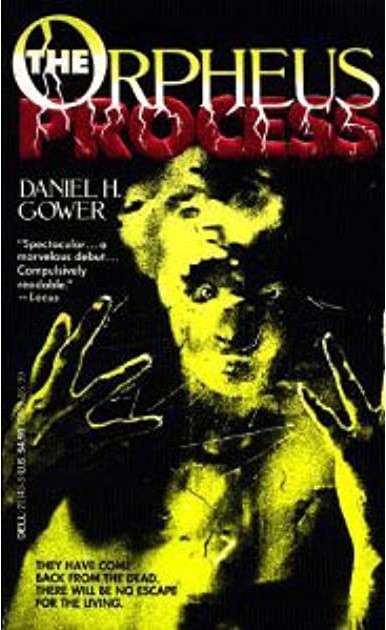 By DANIEL H. GOWER (Dell; 1992)
By DANIEL H. GOWER (Dell; 1992)
Another worthwhile dispatch from the Dell Abyss line of horror paperbacks that flourished in the early 1990s. THE ORPHEUS PROCESS, by the debuting Daniel H. Gower, appeared in Abyss’s second year, at which point its grandiose mission—“The Abyss line of cutting-edge psychological horror is committed to publishing the best, most innovative works of dark fiction available”—was beginning to fray. Gower’s novel is indicative of the line’s declining standards in many respects, although it embodies another Abyss mantra: it’s “unlike anything you’ve ever read before.”
The novel concerns Dr. Orville Helmond, a scientist obsessed with raising the dead. To this end he performs unethical experiments on various lab animals, including Lazarus, a monkey who proves to be his first success, and becomes a family pet. Needless to say, Orville’s experimenting doesn’t stop there.
When his seven year old daughter Eunice is shot dead by a deranged Nam vet—on Halloween, no less!—Helmond takes the corpse back to his lab and makes Eunice his first human subject, resurrecting her before his family can find out what happened. All seems well initially, but then Helmond discovers that his undead subjects—Eunice included—display unexpected side effects, leading to an increasingly outrageous stew of mass zombification, bloodletting, shapeshifting (the living dead here can change form and resurrect their dead fellows), insanity, mass destruction and, of course, death.
The novel is unique in its mixture of sophistication (as you’d expect in an Abyss publication) and exploitation. Included are learned dissertations on the ethics of Helmond’s experiments and philosophical ruminations about zombiedom (with Jesus Christ, Prometheus and Faust all namechecked) appearing alongside passages like this one: “Stomping a guinea pig underfoot, he pinned a rhesus between his bicep and armpit, shoved the gun barrel against its head, and watched it split like an egg when he fired.”
The result of this schizophrenic collision of tones is a book that, even at a vastly inflated 420 pages (not atypical for an Abyss release), is consistently readable. It’s a rare novel that can truly be said to have something for everyone.
